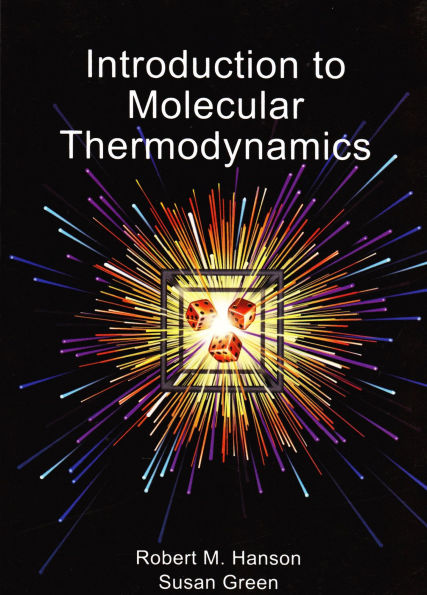Introduction to Molecular Thermodynamics / Edition 1
Starting with just a few basic principles of probabilityand the distribution of energy, this book takes students (and faculty!) on anadventure into the inner workings of the molecular world like no other.
“I wish I had learned thermodynamics this way!” That’s what the authors hear all the time from instructors using Introduction to Molecular Thermodynamics. Starting with just a few basic principles of probability and the distribution of energy, the book takes students (and faculty!) on an adventure into the inner workings of the molecular world like no other. Made to fit into a standard second-semester of a traditional first-year chemistry course, or as a supplement for more advanced learners, the book takes the reader from probability to Gibbs energy and beyond, following a logical step-by-step progression of ideas, each just a slight expansion of the previous. Filled with examples ranging from casinos to lasers, from the “high energy bonds” of ATP to endangered coral reefs, Introduction to Molecular Thermodynamics hits the mark for students and faculty alike who have an interest in understanding the world around them in molecular terms.
1100518565
“I wish I had learned thermodynamics this way!” That’s what the authors hear all the time from instructors using Introduction to Molecular Thermodynamics. Starting with just a few basic principles of probability and the distribution of energy, the book takes students (and faculty!) on an adventure into the inner workings of the molecular world like no other. Made to fit into a standard second-semester of a traditional first-year chemistry course, or as a supplement for more advanced learners, the book takes the reader from probability to Gibbs energy and beyond, following a logical step-by-step progression of ideas, each just a slight expansion of the previous. Filled with examples ranging from casinos to lasers, from the “high energy bonds” of ATP to endangered coral reefs, Introduction to Molecular Thermodynamics hits the mark for students and faculty alike who have an interest in understanding the world around them in molecular terms.
Introduction to Molecular Thermodynamics / Edition 1
Starting with just a few basic principles of probabilityand the distribution of energy, this book takes students (and faculty!) on anadventure into the inner workings of the molecular world like no other.
“I wish I had learned thermodynamics this way!” That’s what the authors hear all the time from instructors using Introduction to Molecular Thermodynamics. Starting with just a few basic principles of probability and the distribution of energy, the book takes students (and faculty!) on an adventure into the inner workings of the molecular world like no other. Made to fit into a standard second-semester of a traditional first-year chemistry course, or as a supplement for more advanced learners, the book takes the reader from probability to Gibbs energy and beyond, following a logical step-by-step progression of ideas, each just a slight expansion of the previous. Filled with examples ranging from casinos to lasers, from the “high energy bonds” of ATP to endangered coral reefs, Introduction to Molecular Thermodynamics hits the mark for students and faculty alike who have an interest in understanding the world around them in molecular terms.
“I wish I had learned thermodynamics this way!” That’s what the authors hear all the time from instructors using Introduction to Molecular Thermodynamics. Starting with just a few basic principles of probability and the distribution of energy, the book takes students (and faculty!) on an adventure into the inner workings of the molecular world like no other. Made to fit into a standard second-semester of a traditional first-year chemistry course, or as a supplement for more advanced learners, the book takes the reader from probability to Gibbs energy and beyond, following a logical step-by-step progression of ideas, each just a slight expansion of the previous. Filled with examples ranging from casinos to lasers, from the “high energy bonds” of ATP to endangered coral reefs, Introduction to Molecular Thermodynamics hits the mark for students and faculty alike who have an interest in understanding the world around them in molecular terms.
64.0
Out Of Stock
5
1

Introduction to Molecular Thermodynamics / Edition 1
318
Introduction to Molecular Thermodynamics / Edition 1
318
64.0
Out Of Stock

From the B&N Reads Blog
